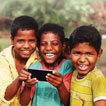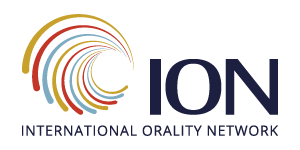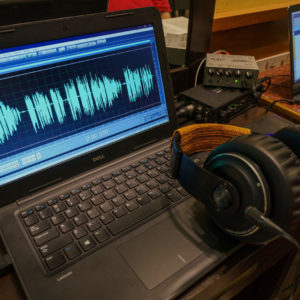A Visual Bible for Each of Their Visual Sign Languages
 Bible translation has been around for centuries, with missionaries venturing out into people groups near and far to make God’s Word accessible to people in a language and form they can clearly understand. As we steadily count down the number of languages left without Scripture, a people group seems to have gone overlooked by many, even though they live among all societies in every city, state and country around the world: the Deaf.
Bible translation has been around for centuries, with missionaries venturing out into people groups near and far to make God’s Word accessible to people in a language and form they can clearly understand. As we steadily count down the number of languages left without Scripture, a people group seems to have gone overlooked by many, even though they live among all societies in every city, state and country around the world: the Deaf.
Deaf Bible Society is an organization with a mission to provide God’s Word in every sign language. In collaboration with their partners, Deaf Bible Society reports that there are more than 400 distinct sign languages in use today. Yet only one completed New Testament exists, in one sign language, making the Deaf one of the most unreached and unengaged people groups in the world.
But why do the Deaf need Bible translation at all? Why can’t they just read the written Scriptures?The staggering statistics indicate that only two to three percent of Deaf people worldwide have been introduced to the truth of a Savior, and almost all Deaf communities are without God’s Word and biblical resources in a language and form they can understand.
Sign languages are not based on “simple” gestures or pantomime representing the national spoken language. They are true languages, rich and complex, with their own syntax and grammar. Sign languages employ facial expression, hand and body movement, and palm orientation to create visual grammar. Deaf people who use sign language as their primary mode of communication depend upon all of the components of this visual grammar to convey meaning, just the same as a hearing person depends upon spoken language grammar to project ideas, purpose and sense of identity.
A Visual Bible for a Visual Language
 Deaf Bible Society and their partners are dedicated to getting God’s Word in the heart language of every Deaf person, and must consider all the specific and detailed nuances that go into constructing biblical content and resources for the Deaf. Instead of the traditional 2D linear words on a page, which fall flat, sign language is dynamic and active, and must be in an accessible multimodal medium to be viewed.
Deaf Bible Society and their partners are dedicated to getting God’s Word in the heart language of every Deaf person, and must consider all the specific and detailed nuances that go into constructing biblical content and resources for the Deaf. Instead of the traditional 2D linear words on a page, which fall flat, sign language is dynamic and active, and must be in an accessible multimodal medium to be viewed.
The broad availability of video technology has blazed a trail for reaching Deaf people with Scripture in a visual form, but there remains a major challenge of translating God’s Word into an estimated 400 sign languages.
The output must use the face, the hands, body movement and expressions all collaborated with clear, natural and accurate signs, which can be unique for every culture and sign language. This presents a challenge that requires cutting-edge technology.
Machine learning has been around since the 1950s, but it has never been on the lips of mechanical engineers, software developers and computer scientists like it is today. It wasn’t that long ago that the general public wasn’t ready to accept things like artificial intelligence (A.I.) and learning bots into their private space. Then along came Siri from Apple and Amazon’s virtual assistant, Alexa, and the world of A.I. exploded. Since then, new gadgets and smart electronics have emerged with life-enhancing algorithms.
Eastern and western populations alike gobble it up daily.
But how can Christian evangelists and ministries take advantage of this sailing ship? Can this kind of advanced technology be used to assist the acceleration of Bible translation and Scripture engagement? If digital assistants can be capable of turning off lights and ordering dinner, then certainly programs can be designed to perform specific, complex tasks like language acquisition. But, can advanced technology like A.I. be used in sign language acquisition? Better yet, can machine learning be used to assist sign language Bible translation?
Thinking Inside the Bot
When a hearing person talks about a translation of the Bible, they refer to the variety of different text and audio versions available like the King James Version, the NIV or the New Living Translation. The reader or the listener rarely connects the team or individual who worked on the translation directly with the final product.
Sign language Bible translation work requires the Deaf person doing the translation to show their face on camera, making that individual permanently connected to the translation. Problems arise when the character of the person overrides the message of Christ and becomes the focus. This can lead to scrutiny when the community recognizes the signer, and the reputation of the person can directly impact the reputation of the translation. In regions hostile to God’s Word, the signer risks putting their entire family, the translation team and the project in danger. The challenge becomes protecting the identity of the signer.
Deaf Bible Society is taking advantage of new technology to build software called Chameleon, which uses machine learning (A.I.) to mask the identity of signers on camera behind visually realistic avatars. Chameleon uses neural networks that are trained with real-time data and are fed information to identify an elbow, an eyebrow and how the lips form in conjunction with a particular facial movement. They work like an active brain to learn the motions and expressions while responding by recognizing bodily connections and coordinated movements. It is like a baby who sees his parent over and over and suddenly starts to smile when the parent walks in the baby responds based on what he is learning. When the output of the neural network is driving the avatar, the signer’s identity remains hidden—fully capturing his movements and signing style while eliminating the risk.
Neural networks have enabled Chameleon to leap years ahead of what was thought possible. “It’s really the dreamers who keep things moving forward,” says the Chameleon team leader. “It wasn’t that long ago that neural networks were considered unpopular. People didn’t think it was possible for computers to learn and self-correct on their own but look at what God is doing for His glory!”
Awareness Builds a Movement
Historically Deaf people have been marginalized, forgotten and unreached. Misunderstood and reduced to a homogenized culture, they are often looked down upon and socially regarded as “disabled.”
In some countries, Deaf people are labeled as leprous, and their deafness is considered a sign of sin. There are many countries where deafness is considered shameful, and Deaf people are cursed and ousted from society. Deaf children and adults are often hidden away, left by their parents, or separated into the very lowest sect. We’ve heard stories of terrible crimes and atrocities committed against Deaf people because they cannot speak out for themselves.
Missionaries seeking Deaf people must often knock on doors to draw out the withdrawn and isolated. When they do reach a Deaf population, churches often mistakenly approach them with services and resources geared toward a hearing audience, which Deaf people must try to fit into.
But as sign language Bible translation makes its way into the light, Deaf culture is being recognized more and more. Advanced technology and social media touch every place around the globe, creating a place for acceptance and change. It is a time when Deaf people must be identified and honored as intrinsic people groups, as an exclusive culture within a culture. Sign languages must come to be fully recognized as true languages, cherished by the Deaf as their heart language.
Deaf Bible Society believes that the Great Commission is true for all people, including the Deaf. We believe the Deaf have a right to access the Bible in their sign language resulting in a personal relationship with God and community within the Church. To learn more about Deaf Bible Society, who we are, and our projects, please visit DeafBibleSociety.com.









